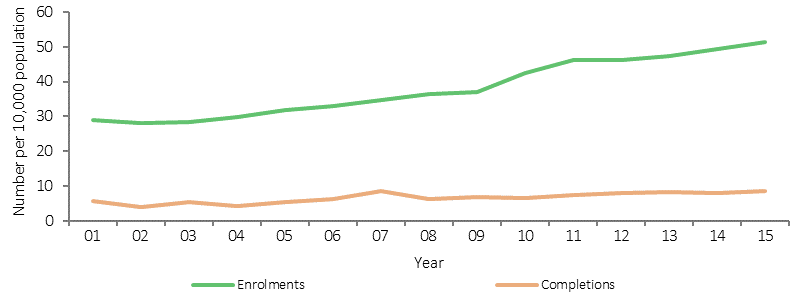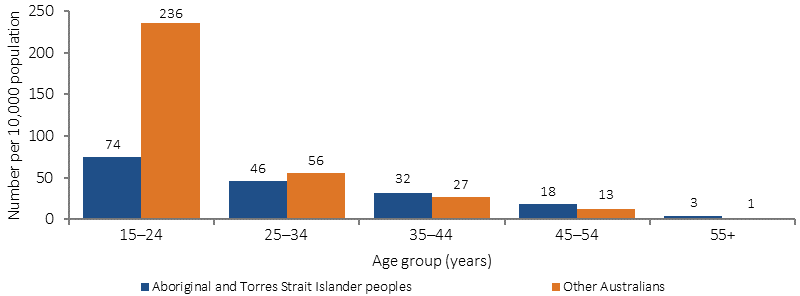3.20 Aboriginal and Torres Strait Islander peoples training for health-related disciplines
Page content
Why is it important?
Aboriginal and Torres Strait Islander peoples are significantly under-represented in the health workforce (see measure 3.12). Improving and supporting the participation of Aboriginal and Torres Strait Islander people in tertiary education for health-related disciplines is vital to increasing Aboriginal and Torres Strait Islander participation in the health workforce.
Findings
In the Higher Education Student Statistics collection for 2015, an estimated 2,475 current enrolments for health-related courses were for Aboriginal and Torres Strait Islander tertiary students, as were 416 health-related course completions. Enrolment rates for Indigenous university students have increased from 29 per 10,000 in 2001 to 51 per 10,000 in 2015. There has also been an increase in completion rates over this period, from 5.6 per 10,000 to 8.6 per 10,000. Enrolment rates increased at a faster rate than completion rates (101% compared with 85%). Between 2001 and 2015 there was also an increase in enrolment and completion rates for non-Indigenous students. This has led to a widening in the gap between Indigenous and non-Indigenous enrolment rates.
The success rate for Indigenous university students studying health-related courses in 2015 was 81% compared with 92% for non-Indigenous students. Health-related course enrolments for Indigenous undergraduate students in 2015 were highest for nursing (1,269 enrolments and 150 completions). In the same year, there were 225 Indigenous students enrolled in public health courses (of these, 112 were in a specific Indigenous health course) and there were 30 completions. There were an estimated 214 Indigenous enrolments for medicine with the proportion of enrolments for Indigenous undergraduates in medical studies comparable to that for non-Indigenous students. Indigenous student enrolments rates for health-related courses were lower than non-Indigenous student rates in the younger age groups, but exceeded non-Indigenous student rates in the older age groups (35 plus years).
Vocational Education and Training (VET) attracts the highest proportion of Indigenous students studying and completing health-related courses. In 2015 there were 5,910 Indigenous student enrolments in health-related courses in the VET sector and 1,275 completions. Indigenous students were around 1.5 times more likely to be enrolled in health-related courses as non-Indigenous students (123 per 10,000 compared with 79 per 10,000). Rates for completions were also higher for Indigenous students (27 per 10,000 compared with 19 per 10,000).
The Indigenous completion rate has improved significantly between 2003 and 2014 (from 7.8 per 10,000 to 21.6 per 10,000); and this rate of improvement was faster than for non-Indigenous completions.
The most common type of health-related course for Aboriginal and Torres Strait Islander VET students was public health (2,795 enrolments and 766 completions) followed by nursing (791 enrolments and 142 completions).
In 2015, there were 297 VET sector completions for the Aboriginal and Torres Strait Islander Health Worker course in Australia. Women accounted for 64% of the student completions in this course. The VET load pass rate for Indigenous students studying health-related courses was 75% compared with 80% for non-Indigenous students.
Figures
Table 3.20-1
Undergraduate domestic enrolments and completions in health-related courses by Indigenous status, 2015
| Enrolments | Completions | |||||||
|---|---|---|---|---|---|---|---|---|
| Number | Number per 10,000 | Number | Number per 10,000 | |||||
| Indigenous | Non-Indigenous | Indigenous | Non-Indigenous | Indigenous | Non-Indigenous | Indigenous | Non-Indigenous | |
| Nursing | 1,269 | 52,518 | 26.4 | 27.9 | 150 | 10,168 | 3 | 5 |
| Public health | 225 | 10,214 | 4.7 | 5.4 | 30 | 1,854 | 1 | 1 |
| Indigenous health | 112 | 32 | 2.3 | 0.0 | 21 | 6 | 0 | 0 |
| Medical studies | 214 | 10,571 | 4.4 | 5.6 | n.p. | 2,511 | n.p. | 1 |
| Rehabilitation therapies | 205 | 19,727 | 4.3 | 10.5 | 38 | 3,403 | 1 | 2 |
| Dental studies | n.p. | 2,472 | n.p. | 1.3 | < 5 | n.p. | n.p. | n.p. |
| Pharmacy | 25 | 5,334 | 0.5 | 2.8 | < 5 | n.p. | n.p. | n.p. |
| Radiography | n.p. | 3,128 | n.p. | 1.7 | n.p. | 578 | n.p. | 0 |
| Optical science | < 5 | n.p. | n.p. | n.p. | < 5 | n.p. | n.p. | n.p. |
| Total domestic undergraduates(a) | 2,001 | 102,670 | 41.6 | 54.5 | 270 | 19,709 | 6 | 10 |
| Total(b) | 2,476 | 164,061 | . . | . . | 416 | 39,206 | . . | . . |
(a) Only the major course of each student is counted, so a student studying multiple courses is only counted once.
(b) Includes undergraduate, postgraduate, domestic and international students
n.p. not published
Source: AIHW analysis of Higher Education Student Statistics Collection
Figure 3.20-1
Indigenous Australian university student enrolments and completions in health-related courses, 2001 to 2015

Source: AIHW analysis of Higher Education Student Statistics Collection
Figure 3.20-2
Undergraduate domestic health-related course enrolments by Indigenous status and age group, 2015

Source: AIHW analysis of Selected Higher Education Statistics
Table 3.20-2
Vocational education and training (VET) sector student enrolments and completions in health-related courses, 2015
| Enrolments | Completions | |||||||
|---|---|---|---|---|---|---|---|---|
| Number | Rate (per 10.000) | Number | Rate (per 10,000) | |||||
| Indigenous | Non-Indigenous | Indigenous | Non-Indigenous | Indigenous | Non-Indigenous | Indigenous | Non-Indigenous | |
| Public health | 2,795 | 44,990 | 58.1 | 23.9 | 766 | 10,965 | 15.9 | 5.8 |
| Nursing | 791 | 27,688 | 16.4 | 14.7 | 142 | 6,699 | 3.0 | 3.6 |
| Dental studies | 199 | 5,750 | 4.1 | 3.1 | 65 | 2,290 | 1.4 | 1.2 |
| Complementary therapies | 385 | 18,940 | 8.0 | 10.1 | 69 | 5,908 | 1.4 | 3.1 |
| Rehabilitation therapies | 26 | 98 | 0.5 | 0.1 | 18 | 33 | 0.4 | 0.0 |
| Medical studies | 16 | 1,668 | 0.3 | 0.9 | - | 112 | - | 0.1 |
| Optical science | 9 | 621 | 0.2 | 0.3 | 2 | 273 | 0.0 | 0.1 |
| Pharmacy | 5 | 1,197 | 0.1 | 0.6 | 1 | 523 | 0.0 | 0.3 |
| Other health | 2,325 | 70,291 | 48.3 | 37.3 | 212 | 8,301 | 4.4 | 4.4 |
| Total | 5,910 | 148,595 | 122.8 | 78.9 | 1,275 | 35,104 | 26.5 | 18.6 |
Students may enrol in more than one course
Source: AIHW and NCVER analysis of National VET Provider Collection 2015 and National VET in Schools Collection 2015.
Implications
Trends to 2014 show significant success in the VET sector. There has also been a significant improvement in higher education; however, the gap has not improved.
Aboriginal and Torres Strait Islander health professional organisations are funded to support the Indigenous health workforce and promote a culturally appropriate health care system. They support the training of Indigenous Australians in health-related professions through mentoring, professional development, advice and practical support for students and prospective students.
Funding is provided for the Leaders in Indigenous Medical Education (LIME) Network to promote and support effective teaching and learning about Aboriginal and Torres Strait Islander health in medical education, and the successful participation of Indigenous Australians in medical education programmes. The LIME Network facilitates key relationships between ACCHOs and medical schools to improve collaboration, student placement opportunities and research initiatives.
Support has been provided to assist 169 Aboriginal and Torres Strait Islander Health Workers to obtain the Certificate IV required for Practitioner registration, and 95 were trained to supervise and assess those undertaking this course.
The Puggy Hunter Memorial Scholarship Scheme continues to provide scholarships for Aboriginal and Torres Strait Islander students in most health disciplines. Since 2002, more than 1,540 scholarships have been awarded. In 2016, there were 363 participants completing their courses.
Indigenous aged care workforce training programmes—the Rural and Remote Training Program (RRTP), NT Training Program (NTTP) and Indigenous Remote Service Delivery Traineeships (IRSDT)—provide culturally appropriate, relevant, and accredited entry-level certificates through to an advanced diploma to Aboriginal and Torres Strait Islander aged care workers, chiefly for those employed in Indigenous health and aged care services.
Strategies are required to increase enrolment in courses for the health disciplines in which Indigenous students are under-represented. Some medical schools have been significantly more successful in attracting and retaining Indigenous medical students. These schools have adopted comprehensive approaches including: locally based strategies involving personal contact and community engagement, building relationships with potential students and their families and communities, and Indigenous medical or health support units. Indigenous Australian medical students reported the presence of a support unit as their main reason for choosing a university (57%). The presence of Indigenous staff within the school was also important, along with mentoring, curriculum and cultural safety (Minniecon & Kong, 2005). Similarly for nursing, appointing Indigenous nursing academics, building partnerships between nursing schools and Indigenous Education Support Units, and implementing tailored cross-cultural awareness programs for nurse academics have been proposed to enable successful course completions by Indigenous nursing students (West, R et al, 2014).
Improvements in secondary school educational retention and attainment are also necessary (see measure 2.05).